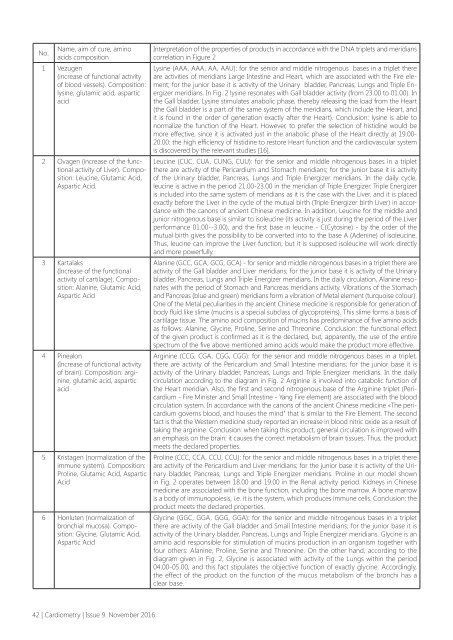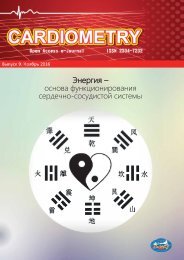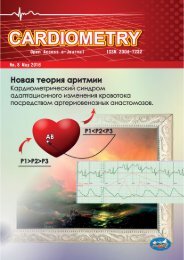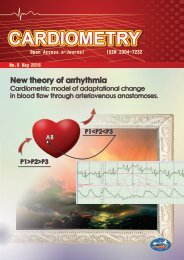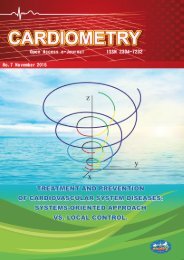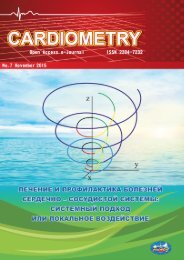Open access e-journal Cardiometry - No.9 November 2016
As might be seen, our Journal is a theme-oriented publication so that each issue offers concentrated materials targeting a certain topic. The present publication is treating the very topical problem: it is energy of the heart.
As might be seen, our Journal is a theme-oriented publication so that each issue offers concentrated materials targeting a certain topic. The present publication is treating the very topical problem: it is energy of the heart.
Create successful ePaper yourself
Turn your PDF publications into a flip-book with our unique Google optimized e-Paper software.
No.<br />
Name, aim of cure, amino<br />
acids composition<br />
1 Vezugen<br />
(increase of functional activity<br />
of blood vessels). Composition:<br />
lysine, glutamic acid, aspartic<br />
acid<br />
2 Ovagen (increase of the functional<br />
activity of Liver). Composition:<br />
Leucine, Glutamic Acid,<br />
Aspartic Аcid.<br />
3 Kartalaks<br />
(Increase of the functional<br />
activity of cartilage). Composition:<br />
Alanine, Glutamic Acid,<br />
Aspartic Acid<br />
4 Pinealon<br />
(Increase of functional activity<br />
of brain). Composition: arginine,<br />
glutamic acid, aspartic<br />
acid<br />
5 Kristagen (normalization of the<br />
immune system). Composition:<br />
Proline, Glutamic Acid, Aspartic<br />
Acid<br />
6 Honluten (normalization of<br />
bronchial mucosa). Composition:<br />
Glycine, Glutamic Acid,<br />
Aspartic Acid<br />
Interpretation of the properties of products in accordance with the DNA triplets and meridians<br />
correlation in Figure 2<br />
Lysine (AAA, AAA, AA, AAU): for the senior and middle nitrogenous bases in a triplet there<br />
are activities of meridians Large Intestine and Heart, which are associated with the Fire element;<br />
for the junior base it is activity of the Urinary bladder, Pancreas, Lungs and Triple Energizer<br />
meridians. In Fig. 2 lysine resonates with Gall bladder activity (from 23.00 to 01.00). In<br />
the Gall bladder, Lysine stimulates anabolic phase, thereby releasing the load from the Heart<br />
(the Gall bladder is a part of the same system of the meridians, which include the Heart, and<br />
it is found in the order of generation exactly after the Heart). Conclusion: lysine is able to<br />
normalize the function of the Heart. However, to prefer the selection of histidine would be<br />
more effective, since it is activated just in the anabolic phase of the Heart directly at 19.00-<br />
20.00: the high efficiency of histidine to restore Heart function and the cardiovascular system<br />
is discovered by the relevant studies [16].<br />
Leucine (CUC, CUA, CUNG, CUU): for the senior and middle nitrogenous bases in a triplet<br />
there are activity of the Pericardium and Stomach meridians; for the junior base it is activity<br />
of the Urinary bladder, Pancreas, Lungs and Triple Energizer meridians. In the daily cycle,<br />
leucine is active in the period 21.00-23.00 in the meridian of Triple Energizer. Triple Energizer<br />
is included into the same system of meridians as it is the case with the Liver, and it is placed<br />
exactly before the Liver in the cycle of the mutual birth (Triple Energizer birth Liver) in accordance<br />
with the canons of ancient Chinese medicine. In addition, Leucine for the middle and<br />
junior nitrogenous base is similar to isoleucine (its activity is just during the period of the Liver<br />
performance 01.00--3.00), and the first base in leucine - C(Cytosine) - by the order of the<br />
mutual birth gives the possibility to be converted into to the base A (Adenine) of isoleucine.<br />
Thus, leucine can improve the Liver function, but it is supposed isoleucine will work directly<br />
and more powerfully.<br />
Alanine (GCC, GCA, GCG, GCA) - for senior and middle nitrogenous bases in a triplet there are<br />
activity of the Gall bladder and Liver meridians; for the junior base it is activity of the Urinary<br />
bladder, Pancreas, Lungs and Triple Energizer meridians. In the daily circulation, Alanine resonates<br />
with the period of Stomach and Pancreas meridians activity. Vibrations of the Stomach<br />
and Pancreas (blue and green) meridians form a vibration of Metal element (turquoise colour).<br />
One of the Metal peculiarities in the ancient Chinese medicine is responsible for generation of<br />
body fluid like slime (mucins is a special subclass of glycoproteins). This slime forms a basis of<br />
cartilage tissue. The amino acid composition of mucins has predominance of five amino acids<br />
as follows: Alanine, Glycine, Proline, Serine and Threonine. Conclusion: the functional effect<br />
of the given product is confirmed as it is the declared, but, apparently, the use of the entire<br />
spectrum of the five above mentioned amino acids would make the product more effective.<br />
Arginine (CCG, CGA, CGG, CGG): for the senior and middle nitrogenous bases in a triplet,<br />
there are activity of the Pericardium and Small Intestine meridians; for the junior base it is<br />
activity of the Urinary bladder, Pancreas, Lungs and Triple Energizer meridians. In the daily<br />
circulation according to the diagram in Fig. 2 Arginine is involved into catabolic function of<br />
the Heart meridian. Also, the first and second nitrogenous base of the Arginine triplet (Pericardium<br />
- Fire Minister and Small Intestine - Yang Fire element) are associated with the blood<br />
circulation system. In accordance with the canons of the ancient Chinese medicine «The pericardium<br />
governs blood, and houses the mind" that is similar to the Fire Element. The second<br />
fact is that the Western medicine study reported an increase in blood nitric oxide as a result of<br />
taking the arginine. Conclusion: when taking this product, general circulation is improved with<br />
an emphasis on the brain: it causes the correct metabolism of brain tissues. Thus, the product<br />
meets the declared properties.<br />
Proline (CCC, CCA, CCU, CCU): for the senior and middle nitrogenous bases in a triplet there<br />
are activity of the Pericardium and Liver meridians; for the junior base it is activity of the Urinary<br />
bladder, Pancreas, Lungs and Triple Energizer meridians. Proline in our model shown<br />
in Fig. 2 operates between 18.00 and 19.00 in the Renal activity period. Kidneys in Chinese<br />
medicine are associated with the bone function, including the bone marrow. A bone marrow<br />
is a body of immunopoiesis, i.e. it is the system, which produces immune cells. Conclusion: the<br />
product meets the declared properties.<br />
Glycine (GGC, GGA, GGG, GGA): for the senior and middle nitrogenous bases in a triplet<br />
there are activity of the Gall bladder and Small Intestine meridians; for the junior base it is<br />
activity of the Urinary bladder, Pancreas, Lungs and Triple Energizer meridians. Glycine is an<br />
amino acid responsible for stimulation of mucins production in an organism together with<br />
four others: Alanine, Proline, Serine and Threonine. On the other hand, according to the<br />
diagram given in Fig. 2, Glycine is associated with activity of the Lungs within the period<br />
04.00-05.00, and this fact stipulates the objective function of exactly glycine. Accordingly,<br />
the effect of the product on the function of the mucus metabolism of the bronchi has a<br />
clear base.<br />
42 | <strong>Cardiometry</strong> | Issue 9. <strong>November</strong> <strong>2016</strong>


